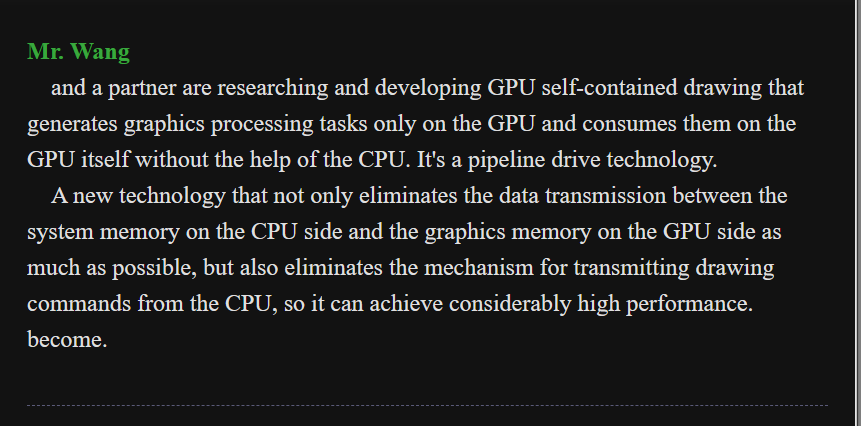AMD senior execs including head of Radeon Technologies Group, David Wang, sat down with 4Gamer , 2 months ago, to talk about their future GPU strategy including the RDNA 4 graphics architecture.
https://www-4gamer-net.translate.go...083/?_x_tr_sl=auto&_x_tr_tl=en&_x_tr_hl=en-GB
(Change detected language to Japanese)
1. Primitive Shader as hardware exists in everything from Radeon RX Vega to the latest RDNA 3-based GPU. When viewed from DirectX 12, Radeon GPU's Primitive Shader is designed to work as a Mesh Shader.
2. AMD's RDNA 3rd generation GPU is equipped with "Multi Draw Indirect Accelerator" (MDIA) that processes MDI in hardware. As a result, AMD appealed that the execution of MDI was 2.3 times faster than RDNA 2.
In the previously mentioned Mesh Shader, one 3D model is divided into multiple parts (domains) and drawn in units of "Meshlet" (meshlet). MDI is expected to be used for high-speed processing of this drawing ( related link ).
For example, the idea of using Meshlets has been proposed as a technology that replaces the classic Level of Detail (LoD) mechanism that replaces 3D models with different degrees of detail depending on the perspective
"We would like to propose this as a new standard specification for the GPU programming model," Wang said. Will this be installed as a new feature in the RDNA 4th generation GPU?
3. There is also a slightly more basic genre in the neural graphics theme that AMD and NVIDIA have started working on as promising for real-time game graphics. Specifically, rather than seriously calculating various elements of 3D game graphics, it is an effort to make it look like it with AI-based inference.
For example, if it is about lighting with direct light, it is faster and more accurate to let the GPU calculate it, but lighting with global lighting including indirect light is vague in appearance, but the amount of calculation required is enormous. In game graphics, there are many cases where you don't have to worry about accuracy as long as it is persuasive, so neural graphics are suitable for such themes.
As an example, NVIDIA announced at SIGGRAPH 2020 a global lighting technology that generates indirect lighting for 3D scenes using AI support using the contents of the "G-Buffer" generated during deferred rendering
https://www-4gamer-net.translate.go...083/?_x_tr_sl=auto&_x_tr_tl=en&_x_tr_hl=en-GB
(Change detected language to Japanese)
1. Primitive Shader as hardware exists in everything from Radeon RX Vega to the latest RDNA 3-based GPU. When viewed from DirectX 12, Radeon GPU's Primitive Shader is designed to work as a Mesh Shader.
2. AMD's RDNA 3rd generation GPU is equipped with "Multi Draw Indirect Accelerator" (MDIA) that processes MDI in hardware. As a result, AMD appealed that the execution of MDI was 2.3 times faster than RDNA 2.
In the previously mentioned Mesh Shader, one 3D model is divided into multiple parts (domains) and drawn in units of "Meshlet" (meshlet). MDI is expected to be used for high-speed processing of this drawing ( related link ).
For example, the idea of using Meshlets has been proposed as a technology that replaces the classic Level of Detail (LoD) mechanism that replaces 3D models with different degrees of detail depending on the perspective
"We would like to propose this as a new standard specification for the GPU programming model," Wang said. Will this be installed as a new feature in the RDNA 4th generation GPU?
3. There is also a slightly more basic genre in the neural graphics theme that AMD and NVIDIA have started working on as promising for real-time game graphics. Specifically, rather than seriously calculating various elements of 3D game graphics, it is an effort to make it look like it with AI-based inference.
For example, if it is about lighting with direct light, it is faster and more accurate to let the GPU calculate it, but lighting with global lighting including indirect light is vague in appearance, but the amount of calculation required is enormous. In game graphics, there are many cases where you don't have to worry about accuracy as long as it is persuasive, so neural graphics are suitable for such themes.
As an example, NVIDIA announced at SIGGRAPH 2020 a global lighting technology that generates indirect lighting for 3D scenes using AI support using the contents of the "G-Buffer" generated during deferred rendering
Last edited:
![[H]ard|Forum](/styles/hardforum/xenforo/logo_dark.png)
